C.P. Lesley's Blog, page 23
January 3, 2020
Ushering In 2020

As I’ve mentioned before, I’m not big on New Year’s resolutions as a whole. The annual promises to lose weight, exercise more, master a foreign language or a new musical instrument, and read more books than there are weeks in the year tend to lose their charm—or at least their credibility—after several decades of repetition. That said, I do have goals that I hope to achieve as a writer in 2020. Even if there is no real penalty to not meeting the goals, having them keeps me on track.
Which I guess is also the reason for promising to lose weight, exercise more, and so on ...
Anyhow, here are the writing goals. Those others are between me and my waistline.
(1) Publish Song of the Shaman (Songs of Steppe & Forest 2), on schedule in mid-January. This novel follows the attempts of Grusha, another secondary character from the Legends series, to balance her Russian heritage with life in a steppe horde and her own needs against those of her six-year-old son, whose future presents an increasingly pressing problem as he approaches the age when his training for adulthood will begin.
This one is pretty much a done deal, because the print edition is already available and the Kindle edition up for preorder, with a delivery date of January 14. But I didn’t want to skip its place in the publication sequence, plus there is so much that goes into marketing a new book that its appearance becomes an ongoing project for several months.
(2) Produce a final manuscript of Song of the Sisters (Songs 3) and sketch out book 4, Song of the Sinner.
Songs 3 is actually in its third draft, resting except for collecting comments from my writers’ group before undergoing another round of revision for publication. So that should be doable by the end of the year. A full rough draft of Songs 4 is a longer shot, but I am starting to come up with ideas, so it’s worth including here.
(3) Complete my half of the rough draft of my first historical mystery novel, co-written with P. K. Adams and tentatively titled These Barbarous Coasts.
After a slow start over the summer, this one is roaring along. Patrycja and I have agreed on a full outline (although the plot is already twisting a bit, as my plots tend to do, and I’m struggling not to let it twist so much that I drive her crazy). She’s drafted the prologue and chapter 1, I’ve drafted chapter 2 and sketched the opener for chapter 5. And I have three more full writing days in my holiday leave before I have to go back to full-time work and writing weekends.
Will we make it? Who knows? But the chances are good, and the process is both entertaining and educational, since I’ve never collaborated with another novelist before.
(4) Conduct twelve New Books in Historical Fiction interviews. Also submit links to recent interviews every four weeks for featuring on the Literary Hub.
I have interviews scheduled through June, and the volunteers keep appearing in my mailbox, so I’m hopeful that I can meet—even exceed—this goal. I just sent in January’s interview for processing and interviewed Gabrielle Mathieu about her latest book—which is fantasy based on medieval Europe and can be cross-posted to both our channels—so I’m getting off to a good start.
As for submitting to LitHub, that’s a privilege, so barring memory lapse or computer disaster, I will certainly do my best to fulfill that goal—for my authors’ and the New Books Network’s sakes as much as my own.
(5) Typeset/proof, produce e-books, and in some cases edit Five Directions Press titles scheduled for 2019. The exact lineup is still in play, but in addition to Song of the Shaman (historical fiction/romance), I expect to work on Champion of the Earth—the second book in Gabrielle Mathieu’s YA fantasy series, Berona’s Quest—and River Aria, the third and last novel in Joan Schweighardt’s Rivers trilogy.
Not much to say here. If the books come in, I’ll find time to work on them.
(6) Stay current with online marketing efforts and outreach. This goal includes keeping up with my weekly blog posts, maintaining my website and the Five Directions Press website, and participating regularly in such group features as “Books We Loved” and “Five Directions Press Authors Dish”—as well as regular if not daily appearances on Facebook (as my author self and Five Directions Press), Twitter, and Goodreads.
This one is always a challenge, because there are so many other tasks to fill my days, and neither marketing nor social media are really part of my natural skill set. But we try.
And as always, I wish everyone a splendid new year, with love and success and happiness for you and those you love!
Image purchased by subscription from iClipart.com, no. c1869314.
Published on January 03, 2020 06:00
December 27, 2019
Roundup for 2019
 As always (at least since 2014, when I started this tradition), here in the final post of December I review my goals for 2019 and how well I met them, in preparation for setting new goals for 2020 next week.
As always (at least since 2014, when I started this tradition), here in the final post of December I review my goals for 2019 and how well I met them, in preparation for setting new goals for 2020 next week.On the whole, I met and in some cases exceeded this year’s targets. See below for details.
(1) Publish Song of the Siren (Songs of Steppe & Forest 1), on schedule in late February.
Met. Song of the Siren launched on February 19 with a number of lovely endorsements from fellow writers and, although nowhere near bestseller status, has done well in comparison with my other novels. It has also spurred sales of my earlier books, especially The Golden Lynx and The Not Exactly Scarlet Pimpernel.
(2) Produce a final manuscript of Song of the Shaman (Songs 2) and sketch out book 3, Song of the Sisters.
Exceeded. Song of the Shaman is available for sale as of today and ready for its formal launch date on January 14, 2020, by which time I expect Amazon to have linked the print and paperback versions. Song of the Sisters is now on its second draft, and I have developed a complete outline for a historical murder mystery to be co-written with P. K. Adams and set in Muscovy in 1553. We hope to start the writing any day, with the idea of producing a full draft by next summer and, with luck, eventually a trilogy set in Poland-Lithuania as well as Russia.
(3) Conduct twelve New Books in Historical Fiction interviews.
Exceeded. Demand was heavy from January on, and at one point it looked as if I would have twenty by year’s end, but for various reasons I topped out at eighteen. I also hosted Q&As with authors on this blog about once a month in addition to the podcast interviews for the New Books Network, and I reviewed a number of other books either at length or as part of my quarterly Bookshelf rubric—most often both.
(4) Typeset/proof, produce e-books, and in some cases edit Five Directions Press titles scheduled for 2019.
Met. For a while, it looked as if Song of the Siren might be our only title this year, but in the end we had three. I edited Joan Schweighardt’s Gifts for the Dead (Rivers 2) while she edited Gabrielle Mathieu’s Girl of Fire (Berona’s Quest 1); then I typeset them both and produced the e-books after they finished proofing the typeset files.
(5) Stay current with online marketing efforts and outreach. At a minimum, I plan to keep up my weekly blog posts, maintain my website and the Five Directions Press website, and participate regularly if not every month in such group features as “Books We Loved” and “Five Directions Press Authors Dish.”
Met. Although heavy work commitments meant that I was absent from social media more than is either desirable or wise for a small-press author, I did manage to keep up with my blog, maintain and update my website (hint: book links are now separated by series rather than all crammed into one page) and the Five Directions Press site. I submitted entries for “Books We Loved” in eleven out of twelve months and contributed at least three “Authors Dish” posts, as well as a Spotlight interview with P. K. Adams (conducted before we established the parameters of our joint project).
So not a bad show, all told. Check back next week to find out what I have planned for next year. In the meantime, my best wishes for a wonderful holiday season and a peaceful and productive 2020!
Image: Purchased by subscription from iClipart.com, #c1219315_b.jpg .
Published on December 27, 2019 06:00
December 20, 2019
Island Paradise
 As luck would have it, I’ve never visited Hawaii. I’d love to, someday, but so far I have not.
As luck would have it, I’ve never visited Hawaii. I’d love to, someday, but so far I have not. I first heard of the islands as a schoolchild in the UK, as the place where Captain James Cook died. In those days, Hawaii was an independent kingdom, although portrayed as a savage, uncivilized one in the colonialist textbook of my primary (elementary) school. Of course, this was the same textbook that reduced the six-year American War of Independence to a paragraph stating that King George III kindly released the colonists from their obligations to the crown in response to a few disturbances. When I moved across the Atlantic at the age of eleven, I soon learned the other side to that story, and it wasn’t hard to imagine that the Hawaiians might have had good reasons for objecting to Captain Cook as well.
There in Chicago, I learned about Hawaii as the fiftieth state, an island paradise where folks from the other forty-nine wanted to hang out on their vacations. Sun, beach, sea, mountains—even a kid in junior high school could appreciate the appeal. There was a casual mention of annexation in my US history classes, but that appeared as little more than a footnote on the way to rounding out the national roster—glossed over along with all the other stories of conquest and exploitation in favor of emphasis on the Louisiana Purchase and the $7 million that William Seward paid for Alaska. A different picture, for sure, stripped of the savage and uncivilized element, but not much more accurate for all that.
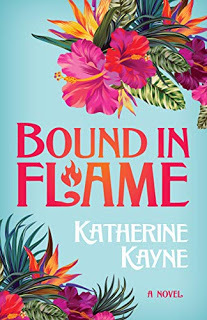 The Hawaii portrayed in Katherine Kayne’s Bound in Flame, the subject of my latest interview for New Books in Historical Fiction, is, in contrast, a vibrant and multifaceted place—still wrestling with the reality of US annexation, the loss of the islands’ independence, the overthrow of its royal family, and the assault on its ancient culture. There are certainly beaches, mountains, and flowers by the cartload, but the story behind the story is darker, grittier, and more realistic than the glorious photos of Waikiki with which we’re so familiar. Richer, too, since this is a tale of an island kingdom that valued education, experienced a deep attachment to the land and its creatures, and supported strong and assertive women—riders, spiritual leaders, rulers—at a time when much of the mainland insisted that females should see themselves solely as “angels about the house.”
The Hawaii portrayed in Katherine Kayne’s Bound in Flame, the subject of my latest interview for New Books in Historical Fiction, is, in contrast, a vibrant and multifaceted place—still wrestling with the reality of US annexation, the loss of the islands’ independence, the overthrow of its royal family, and the assault on its ancient culture. There are certainly beaches, mountains, and flowers by the cartload, but the story behind the story is darker, grittier, and more realistic than the glorious photos of Waikiki with which we’re so familiar. Richer, too, since this is a tale of an island kingdom that valued education, experienced a deep attachment to the land and its creatures, and supported strong and assertive women—riders, spiritual leaders, rulers—at a time when much of the mainland insisted that females should see themselves solely as “angels about the house.” As always, the rest of this post comes from New Books in Historical Fiction.
Leticia Liliuokalani Lang, better known as Letty, has good intentions, but her strong will and quick temper tend to get in her way. Banished from her Hawaiian home due to a conflict with her stepmother, Letty winds up in a California boarding school, where she decides to devote her career to healing animals—even though female veterinarians are scarcer than the proverbial hen’s teeth in 1906.
On the ship back to her beloved islands, Letty notices a beautiful racehorse and realizes the horse’s trainer is abusing him. An accident in the harbor sends the stallion into the ocean, and Letty dives in to save him without a second thought. That sets her on a collision course with the horse’s owner and trainer after she insults the former and reports on the latter’s mistreatment. All this before Letty even reaches her home and confronts the stepmother who sent her away.
Letty learns that she has a magical gift that challenges her self-control but acts as a source of strength and connection. She is one of nine Gates, bound to the earth, born with the ability to harness its power—represented by the flames of her spirit—to direct her intentions, for good or for ill. But Letty resists her destiny, knowing that her gift comes at a cost: a lifetime alone.
In this delightful debut novel Katherine Kayne sweeps us back to a Hawaii still mourning its lost kingdom, where ladies—their ballgowns covered in yards of protective fabric—gallop across the mountains and down the city streets on their way to polo matches and parties, men dance the hula as well as women, and flowers are everywhere. It’s no accident that Bound in Flame kicks off a brand-new series, aptly called The Hawaiian Ladies Riding Society.
Image: Lei © Sanba38 - Own work, CC BY-SA 3.0, via Wikimedia Commons.
Published on December 20, 2019 08:06
December 13, 2019
Milestones
 Yesterday I recorded the hundredth interview for New Books in Historical Fiction. It should go up next week, or at any rate before Christmas, and it will take us to early twentieth-century Hawaii, which is exactly where I’d like to be as the snow and long nights close in.
Yesterday I recorded the hundredth interview for New Books in Historical Fiction. It should go up next week, or at any rate before Christmas, and it will take us to early twentieth-century Hawaii, which is exactly where I’d like to be as the snow and long nights close in.Of the hundred interviews that have posted or soon will, ninety-nine are mine—recorded over seven years, including eighteen this year alone. So it seems like a good time to stop and take stock. It’s been a great deal of fun, and I hope to keep going. I’ve made great connections, talked to many wonderful authors, and even started a few friendships. And all because of a mistake.
A mistake? Well, you see, when I first approached Marshall Poe—the editor in chief of the New Books Network (NBN) and, not coincidentally, a fellow Muscovite historian—back in 2012, I just wanted to get some publicity for The Golden Lynx , then hot off the press. I’d seen a reference to the NBN in the journal I edit, and when I checked the site address, I saw a reference to a channel called New Books in Historical Fiction. At that point in time, I still had so little idea of what the NBN was that I didn’t understand it involved podcasts. (In truth, back then I wasn’t quite sure about podcasts, either, although I did know they were audio recordings.) But I knew Marshall from way back, so I wrote to him and asked for an interview.
Well, to cut a long story short, the NBN had a channel for historical fiction but no host. Marshall offered me the job, and I almost didn’t take it. In high school I was a nerd, and shy as all get out (this news amazes people who know me now, but it’s true). My husband called radio stations for contests or to make comments; I never did. The idea of getting on a microphone and talking on the air was alien to me. But then I thought about it and decided: why not? I had to grow up sometime. And I’d get to talk to fellow writers. How bad could it be? So I said yes.
 Early on, while I was making every mistake imaginable—including my second interview, where I managed to press the buttons in the wrong sequence and record only my side of the interview, not my guest’s—I had the good fortune to link up with Heather Drucker, the publicity director at HarperCollins. A stunningly competent and responsive publicist, Heather has sent me more authors than I can count. She’s arranged three podcast interviews, as well as two blog posts and a written Q&A, with Bernard Cornwell. She’s also connected me with half of her staff, who routinely send me books to consider and set up interviews as needed. One landed on my doorstep just the other day.
Early on, while I was making every mistake imaginable—including my second interview, where I managed to press the buttons in the wrong sequence and record only my side of the interview, not my guest’s—I had the good fortune to link up with Heather Drucker, the publicity director at HarperCollins. A stunningly competent and responsive publicist, Heather has sent me more authors than I can count. She’s arranged three podcast interviews, as well as two blog posts and a written Q&A, with Bernard Cornwell. She’s also connected me with half of her staff, who routinely send me books to consider and set up interviews as needed. One landed on my doorstep just the other day.Also in those first few months, a chance connection on GoodReads, the social media site for readers, brought me into contact with Caitlin Hamilton Summie, an author and independent publicist who represents authors at many levels of publishing. In addition to these two wonderful ladies, I’ve approached quite a number of authors directly or by responding to e-mail requests. In the beginning, I was amazed and grateful that people even answered my e-mails and agreed to talk with me. These days, I rarely have an unfilled slot in my schedule (I’m booked now well into next year), but I’m still touched by authors’ willingness to share their literary worlds with me, whether those involve Austen’s England or some new angle on World War II.
In the meantime, the NBN has grown dramatically. From one channel in 2010, it’s expanded to more than eighty, although most of those focus on academic subjects (exceptions include historical fiction, fantasy and adventure, science fiction, literature, and poetry). We’ve established a partnership with the Literary Hub, which posts links to new interviews every Friday. And as of last report, we’re on track to serve nine million interviews in 2019. How many of them are mine, I don’t know, but I do know that we have listeners in Europe and Australia as well as North America, which is very cool.
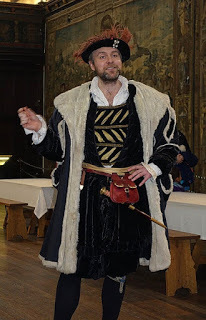 So have I sold many books, which was my original goal? Not really. A few, certainly, on occasions when I’ve been the guest rather than the host. But there are so many other benefits to this gig. The interviews give me something to post on social media that focuses on others rather than myself. I’ve made the acquaintance of many wonderful writers and enjoyed many fascinating conversations about writing. I’ve gotten a few endorsements for my books and visits to this blog. Through interviews I made the acquaintance of Joan Schweighardt, who has since joined Five Directions Press, and P. K. Adams, now a partner on that “Tudors meet Romanovs” mystery that I’ve mentioned in previous posts, now fully outlined and ready to write. For all those reasons, I’m so glad I took the chance and said yes when Marshall asked.
So have I sold many books, which was my original goal? Not really. A few, certainly, on occasions when I’ve been the guest rather than the host. But there are so many other benefits to this gig. The interviews give me something to post on social media that focuses on others rather than myself. I’ve made the acquaintance of many wonderful writers and enjoyed many fascinating conversations about writing. I’ve gotten a few endorsements for my books and visits to this blog. Through interviews I made the acquaintance of Joan Schweighardt, who has since joined Five Directions Press, and P. K. Adams, now a partner on that “Tudors meet Romanovs” mystery that I’ve mentioned in previous posts, now fully outlined and ready to write. For all those reasons, I’m so glad I took the chance and said yes when Marshall asked. And although I still find new mistakes to make, I’ve become completely comfortable chatting with people on the air—something I never expected that day when I sent an e-mail asking for an interview about The Golden Lynx.
Maybe I’ll even call a radio station someday. But then, why bother, when I have this lovely channel of my own?
Images: Lei of plumaria by Carrie Chan; “On Air” sign by Kaufdex—all via Pixabay (no attribution required).
Published on December 13, 2019 06:00
December 6, 2019
Interview with Molly Greeley
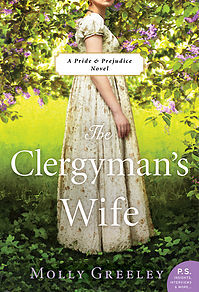 I have to admit, for all the times I’ve read and watched Jane Austen’s Pride and Prejudice, until I encountered Molly Greeley’s new novel,
The Clergyman’s Wife
, I had never spent a moment wondering what happened to Charlotte Lucas and the Reverend William Collins after their marriage. For people who have somehow managed to avoid the novel in all its forms, Charlotte is the plain, older (twenty-seven, which to me now seems very young!) friend of Pride and Prejudice’s heroine, Elizabeth Bennet, and William Collins is the fly in the Bennet daughters’ ointment—the little-known heir to their father’s estate, who has illusions of further strengthening his claim by marrying Elizabeth.
I have to admit, for all the times I’ve read and watched Jane Austen’s Pride and Prejudice, until I encountered Molly Greeley’s new novel,
The Clergyman’s Wife
, I had never spent a moment wondering what happened to Charlotte Lucas and the Reverend William Collins after their marriage. For people who have somehow managed to avoid the novel in all its forms, Charlotte is the plain, older (twenty-seven, which to me now seems very young!) friend of Pride and Prejudice’s heroine, Elizabeth Bennet, and William Collins is the fly in the Bennet daughters’ ointment—the little-known heir to their father’s estate, who has illusions of further strengthening his claim by marrying Elizabeth.But to my amazement, by the time I finished The Clergyman’s Wife, not only was I delighted to have renewed my acquaintance with Charlotte but capable of mustering some sympathy for the otherwise risible Mr. Collins. How Molly Greeley works this miracle you’ll have to discover for yourself, but here are a few insights into what got her started on this project and where she goes with it.
Pride and Prejudice novels are, in a way, the gold standard of publishing dreams, especially if an author can come up with a new take on the Bennet sisters’ story, which you certainly have. Where did the idea come from to focus on Charlotte Lucas and the Reverend Williams Collins?
To be completely honest, I have always found Charlotte’s story even more compelling than Elizabeth Bennet’s, perhaps because it’s (much) less of a fairy tale. Though Lizzy is brave in one way, determined not to compromise her values in favor of security, Charlotte has her own brand of courage, taking charge of her own life in the best way available to her.
Like all of Austen’s novels, there is a lot in Pride and Prejudice about women’s financial insecurity; but because the heroine falls into the arms of a man with ten thousand a year, the actual fallout of the inequalities between men and women during this time period doesn’t fully play out, at least for Elizabeth Bennet. But Charlotte’s story offers an opportunity to explore more deeply what might have happened to women who did not feel comfortable sacrificing their own and their family’s comfort for the sake of romantic love that, realistically speaking, may or may not ever arrive. Lizzy’s story is more palatable to our modern sensibilities, particularly since most modern women don’t face destitution if they don’t marry; but Charlotte’s story is probably closer to the truth of what many women in Austen’s time experienced.
Although Elizabeth (Lizzy) Bennet’s good friend, Charlotte is a bit player in Austen’s novel. Who is she as a character there, and how have marriage and motherhood changed her in your book, which starts a few years later?
In Pride and Prejudice, Charlotte is shown to be by turns playful—urging Lizzy to play the pianoforte, teasing her about Mr. Darcy—and practical to a fault. She thinks that Jane Bennet ought, in order to “secure” the rich, handsome Mr. Bingley, to pretend to a deeper affection for him than she is comfortable displaying until she knows him better; and she herself sets out to seduce Mr. Collins with her sympathy and attention, even while suspecting that she can never truly respect him. We know that she is intelligent and interesting enough to be good friends with Elizabeth, whose wit and love of a good laugh indicate she likely wouldn’t be friends with a bore.
When Lizzy returns home from visiting Charlotte and William after their marriage, she reflects that Charlotte’s “home and her housekeeping, her parish and her poultry … had not yet lost their charms.” That “yet” seems very telling to me, and so when Chapter One of The Clergyman’s Wife begins three years after Charlotte’s marriage, all of those charms have begun to wear very thin. Her life in Hunsford is very solitary, and in order to slot herself into the role of the good clergyman’s wife according to both William and Lady Catherine de Bourgh, she has lost, or at least buried, much of what would have made her an attractive friend to Lizzy. She is also now mother to a young daughter, and there is a fundamental tension between her realism—she knows deeply how important financial security is for a woman—and her burgeoning understanding that, while important, security simply isn’t enough.
William Collins is, to put it bluntly, not the man of most young women’s dreams. Why does Charlotte make a play for him after Lizzy turns him down?
I love that you said Charlotte “makes a play” for Mr. Collins, because this is exactly what she does, and it’s one of the reasons I love her character so much. She doesn’t set out to seduce him with her body, but by giving him what he really wants: attention. There are so many layers to unwrap here with regards to Charlotte’s character—she is capable of boldness; she is calculating; she is empathic. And then there are the unspoken layers, which Austen may or may not have intended, but which seem, to my mind at least, likely. Layers of fear and insecurity, because, as a woman who lacked both money and beauty, and who was already in her late twenties, her future was precarious. If she didn’t marry, she was going to end up dependent on the charity of her father and, later, her brothers. Depending on her brothers’ (and their wives’) personalities, this could mean a lifetime of being seen as a burden, no matter how she helped in the household. A woman of Charlotte’s standing in society could become a governess, if she were well-educated enough, or a paid lady’s companion; but these, too, were precarious options, and came without the status conferred by being someone’s wife.
So William Collins, for all his many failings, seems like a good option to her—really, the best option she has. He has a respectable position as a clergyman, and when his cousin Mr. Bennet dies, he stands to inherit Longbourn estate. When her friend Lizzy doesn’t snatch him up, Charlotte sees an opportunity and takes it.
And what of William himself? Remind us briefly of how Austen characterizes him, then how you went about making him a more sympathetic character—which you do wonderfully, without changing his fundamental personality as Austen defines him.
Mr. Collins is described as a tall, heavyish man, with very stately manners, who talks a lot without ever saying much of interest. He offers compliments fawningly, and whenever he feels he has offended someone his apologies are just as excessive. By turns vain and self-debasing, he is, basically, awkward in almost every imaginable way. He’s a caricature of a certain type of clergyman from Austen’s time, and a certain type of person, one who is over-awed by titles and riches.
Because my story centers on Charlotte, and because Charlotte is married to William, I knew I had to turn him into something resembling an actual person rather than a caricature. We know from Austen that William’s father and Mr. Bennet, Lizzy’s father, had a falling-out, and we know that his father was “illiterate and miserly.” This provided a jumping-off point in my mind for William’s backstory. And I tried to use little moments—his difficulty connecting with his baby daughter, for instance—to show that under his awkwardness lay an essential insecurity; that he wants to connect with people, but has trouble really doing so.
To be honest, Mr. Collins was not too difficult to humanize because he is never portrayed as a villain in Pride and Prejudice, only as ridiculous. And while ridiculous people may be easy targets in comedy and satire, in life there is usually something deeper going on underneath.
No story about Charlotte and William would be complete without mention of Lady Catherine de Bourgh. What is her role in Charlotte’s life?
Oh, Lady Catherine! Yes, she’s overbearing, certain she always knows best, and much more involved in Charlotte’s life than Charlotte would like. Lady Catherine is William’s patroness, which means it was she who offered him the living at Hunsford parish; however, in my research into the ins and outs of Regency-era clergy, it looks like the living, once given, couldn’t easily be rescinded. So it wasn’t so much that Charlotte and William risked losing their home and livelihood if they didn’t dance attendance upon Lady Catherine; rather, they merely risked the ire of a powerful neighbor, a woman who was petulant and very accustomed to getting her own way.
I mean really, it was probably just easier to bow to Lady Catherine’s whims rather than try to stand against them; having her for an enemy, especially living just across the lane, would be unpleasant to say the least. But there was also the matter of William, who genuinely seemed to be in awe of her ladyship; if she stood up to Lady Catherine, Charlotte would also have to stand up to her husband—in a time when the “obey” in marriage vows was literally meant. And of course, there were the societal strictures of the times, by which someone nobly born like Lady Catherine was automatically offered respect based on her bloodline alone, regardless of how distasteful her company and her meddling might be. So Lady Catherine offers Charlotte “advice” on how to keep house and raise her daughter, and Charlotte nods and smiles and inwardly screams with boredom.
But this story is really about Charlotte’s developing friendship with Mr. Travis, which for me is both beautifully handled and believable. What can you tell us about him, as Charlotte sees him?
Mr. Travis is a farmer, a tenant of Lady Catherine. As such, he isn’t someone Charlotte would ever have considered a suitable match for herself, or any woman of her station. But after they have a chance meeting in the parsonage garden, she discovers he has a sly, irreverent humor, and, more than that, kindness, and an ability to connect, not only with her but with her child.
Mr. Travis is someone who truly sees Charlotte, and truly cares about her. William loves the idea of Charlotte as his wife, but she has never fully been herself in his company—and, in all likelihood, he wouldn’t really understand her if she were. But from the first, Charlotte and Mr. Travis share a sort of fundamental understanding of each others’ characters and situations. In some ways, too, he offers Charlotte what she, herself, offered to William, though on a deeper and more sincere level—someone who truly listens to her.
And what of you? This book came out on Tuesday. Are you already working on another novel?
I am! I have another Austen-inspired novel in the editing stages, and I’m starting work on a contemporary story.
Thank you so much for answering my questions!

Molly Greeley was born in Ann Arbor, Michigan, where her addiction to books was spurred by her parents' floor-to-ceiling bookshelves. A graduate of Michigan State University, she began as an Education major, but switched to English and Creative Writing after deciding that gainful employment was not as important to her as being able to spend several years reading books and writing stories and calling it work.
She lives in Traverse City, Michigan with her husband and three children, and can often be found with her laptop at local coffee shops. Find out more about her at https://www.mollygreeley.com.
Published on December 06, 2019 06:00
November 26, 2019
The Indomitable Uhtred
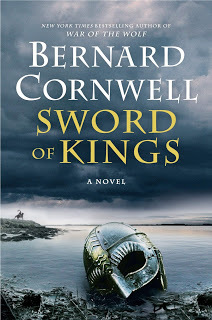 I’ve had the great good fortune to interview the bestselling novelist Bernard Cornwell several times for New Books in Historical Fiction, most recently in reference to his War of the Wolf, which came out last year. I was supposed to interview him again yesterday, but as I reached the midpoint in Uhtred’s latest adventure, Sword of Kings, I realized it would be difficult to talk for 30–35 minutes without either giving away spoilers or forcing Bernard to repeat points he’s already made more than once.
I’ve had the great good fortune to interview the bestselling novelist Bernard Cornwell several times for New Books in Historical Fiction, most recently in reference to his War of the Wolf, which came out last year. I was supposed to interview him again yesterday, but as I reached the midpoint in Uhtred’s latest adventure, Sword of Kings, I realized it would be difficult to talk for 30–35 minutes without either giving away spoilers or forcing Bernard to repeat points he’s already made more than once.This difficulty has nothing to do with the novel itself, which is another page turner, well worth your money and your time. But at no. 12 in a series, every relationship we might discuss has a past, and at this point even naming new characters or mentioning what has happened to old ones robs readers who begin at the beginning from following these developments for themselves.
As it turns out, there was a practical reason for canceling the planned interview and substituting this blog post—one I couldn’t have anticipated at the time. Suffice it to say that the arrival of workmen with hammers and saws and electric drills, however welcome in terms of acquiring a deck that didn’t threaten to collapse under the next person intrepid enough to walk on it, would have severely obstructed our conversation.
So what I have to offer instead is a quick look at the setup of Sword of Kings, which I hope will circumvent the spoiler problem while still encouraging Uhtred fans to pick up the latest installment and those who haven’t yet discovered our favorite Saxon warrior (reared as a Dane and steadfastly pagan despite pressure from all sides to convert to Christianity) to seek out The Last Kingdom in print or on Netflix and get themselves up to speed.
In Sword of Kings, Uhtred is at home in Northumbria, which by the beginning of this novel in 924 has become the last holdout against the campaign of King Alfred the Great’s descendants to reunite all the Saxon kingdoms into a single country that will one day be known as England. Danes still raid the coasts and, when possible, settle in wilder parts of the island, but for the most part the once-separate territories of Wessex, East Anglia, and Mercia have established themselves as a more or less unified Christian nation under the rule of King Alfred’s son Edward.
But after twenty-five years on the throne, Edward dies, leaving an adult heir, Aethelstan, whose legitimacy Edward has placed in question by denying that he was legally married to Aethelstan’s mother; a boy named Aelfweard, whom few people in the kingdom like or respect but who has powerful support from his uncle, who also happens to be a mortal enemy of Uhtred; and Edward’s last wife, who responds to her husband’s death by fleeing with her two children and Aelfweard’s uncle in hot pursuit, determined to put an end to the three of them.
Naturally, Uhtred has to intervene, although at sixty-four he’d much rather remain by his own hearthside and let the English work out their own problems. He knows full well that their unification sets up the conquest of his beloved Northumbria. But Uhtred has sworn an oath, and oaths are serious business for a tenth-century warrior, especially one who hopes to spend his afterlife roistering, drinking, fighting, and wenching in Valhalla. So Uhtred goes south, and in so doing, he again plays a part in realizing King Alfred’s great dream.
The novel releases on November 26, 2019—which is why, as compensation for having to cancel the interview, I’m running this post on Tuesday rather than Friday.
Published on November 26, 2019 07:20
November 22, 2019
You Want Romanovs with That?
In one of those odd cultural conjunctures that manifest themselves from time to time, perhaps because of the centennial of the Romanovs’ execution in 1918, the world’s attention has recently refocused on the long-dead Russian imperial family. Whether indirect—as in Alexei Uchitel’s film Matilda (2017) or Amazon Prime’s hit television series, The Romanoffs (2018)—or more direct (Ariel Lawhon’s I Was Anastasia [2018]; several Russian miniseries now being distributed by Jansen Media), the options available to Romanov buffs have seldom been richer.
It’s a cliché, of course, to point out that historical fiction often follows twisted paths that bear little resemblance to history. Whatever novelists say, fiction about the past can’t be historically accurate in the sense that scholars mean when they use that term. No matter how hard a novelist tries, the need for drama and immediacy and filled-in blanks leads to made-up characters, words put in people’s mouths, thoughts and dreams ascribed to them, and more. Scripts and screenplays, with their compressed time frames, lend themselves even more to a focus on emotional truth and messaging at the expense of the nuance and tolerance of ambiguity that are one of scholarship’s great benefits.
But what ties many of these recent fictional portrayals together is their shoehorning of the Romanovs into stories that stand quite well on their own. There has long been a reluctance to accept that the Bolsheviks could in fact wipe out the entire imperial family and for the next seventy-five years not feel bad about it. But the lasting conviction that Grand Duchess Anastasia survived has now expanded to include other members of the dynasty.
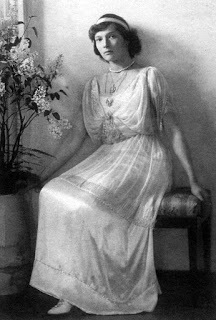 The Romanoffs, for example, follows self-identified descendants of the family around the globe. The series lurches from an unspecified Romanov relative reminiscent of an angrier version of Grand Duchess Swana in the 1938 film Ninotchka—but who is at least not a surviving daughter and who lives in Paris under circumstances possible for unusually wealthy émigrés—to a boy in Australia whose sole connection with Nicholas II seems to be that he suffers from hemophilia. Along the way, it drops in on unhappy couples, a family curse, and a movie star fighting for her career while starring in a film about the Romanov murders, among other scenarios.
The Romanoffs, for example, follows self-identified descendants of the family around the globe. The series lurches from an unspecified Romanov relative reminiscent of an angrier version of Grand Duchess Swana in the 1938 film Ninotchka—but who is at least not a surviving daughter and who lives in Paris under circumstances possible for unusually wealthy émigrés—to a boy in Australia whose sole connection with Nicholas II seems to be that he suffers from hemophilia. Along the way, it drops in on unhappy couples, a family curse, and a movie star fighting for her career while starring in a film about the Romanov murders, among other scenarios.The series has received mixed reviews, but I found it well written, well acted, and generally enjoyable. Except for the movie star, though, why any of the characters need a connection to the historical Romanovs was no clearer to me at the end than at the beginning. You might think the directors had eight unrelated scripts and decided to throw in the Romanovs just to tie them together. The Windsors or the Astors could have served just as well.
I could make a similar point about Gill Paul’s two novels The Secret Wife (2016) and The Lost Daughter (2019). In these books, first Grand Duchess Tatiana, then Grand Duchess Maria, escape the cellar in Ekaterinburg and go on to live full and ultimately rewarding lives. Tatiana ends up in emigration; Maria remains in the nascent Soviet Union, where she endures revolution, civil war, the purges of the 1930s, and the Siege of Leningrad. The Lost Daughter ends with the postwar restoration of Peterhof in the 1970s, so it spans almost the entire Soviet period. In both cases, an additional contemporary story acts as a frame.
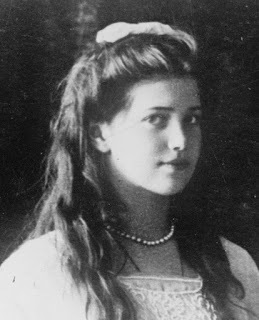 As novels about the Soviet experience, The Secret Wife and The Lost Daughter are lovely. They don’t need the grand duchesses as hooks. The lives of Tatiana and her “husband,” Dmitri Malama, capture the reality of once-privileged émigrés forced to live hand to mouth after the loss of their property and their homes. Maria’s story is even more compelling as she struggles to find her way in a new world that views her family as the enemy, where everything she once valued makes her vulnerable. They could be Maria and Tatiana Ivanova rather than Romanova, but the novels are well researched and deeply thought through.
As novels about the Soviet experience, The Secret Wife and The Lost Daughter are lovely. They don’t need the grand duchesses as hooks. The lives of Tatiana and her “husband,” Dmitri Malama, capture the reality of once-privileged émigrés forced to live hand to mouth after the loss of their property and their homes. Maria’s story is even more compelling as she struggles to find her way in a new world that views her family as the enemy, where everything she once valued makes her vulnerable. They could be Maria and Tatiana Ivanova rather than Romanova, but the novels are well researched and deeply thought through.Yet I wonder: is the story of the Russian Revolution and its consequences not worth telling on its own terms? Do we need to postulate surviving Romanovs and Romanov descendants for people to care?
Perhaps we do. Gill Paul, in her interview with Jennifer Eremeeva on the New Books Network, notes that the Romanovs are “a fairy tale that ended the wrong way,” which she compares with Britain’s Princess Diana, whose death also led to an outbreak of conspiracy theories. There’s probably some truth to that notion. The Bolsheviks’ assassination of the entire family and its servants was bloody and brutal, almost senseless in its violence. We don’t like to think that human beings can act that way.
The sad reality, though, is that human beings did. DNA testing has accounted for the various family members, including Anastasia, Tatiana, and—most recently—Maria. If you want to know what really happened, and why the royal houses of Europe didn’t succeed in intervening in time to save Nicholas II and his family, especially the children, try Helen Rappaport’s The Race to Save the Romanovs: The Truth behind the Secret Plans to Rescue the Russian Imperial Family (2018). A historian with a fluid writing style, Rappaport offers a fascinating but ultimately chilling portrayal of an international system in which the all too human capacity for hauteur, indifference, incompetence, acrimony, and procrastination led to a tragedy that still haunts the imagination more than a century later.
Which, one would think, should be enough of a drama burger even for fiction. You want Romanovs with that?
This post first appeared on “All the Russias,” the blog run by New York University’s Jordan Center for the Advanced Study of Russia, on November 19, 2019.
Images: The Romanov Grand Duchesses Tatiana and Maria in 1914, public domain from Wikimedia Commons.
Published on November 22, 2019 06:00
November 15, 2019
Life between the Wars
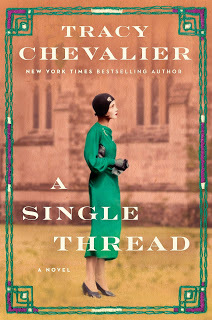 Like many other readers, I first encountered Tracy Chevalier’s novels when I read The Girl With the Pearl Earring, an imagined story about the origins of the famous Vermeer painting that became a major movie starring Scarlett Johansson. I read The Virgin Blue, then somehow lost track of Chevalier’s novels until her US publicist approached me to interview her about the latest book,
A Single Thread
(Viking, 2019). Naturally, I leaped at the chance.
Like many other readers, I first encountered Tracy Chevalier’s novels when I read The Girl With the Pearl Earring, an imagined story about the origins of the famous Vermeer painting that became a major movie starring Scarlett Johansson. I read The Virgin Blue, then somehow lost track of Chevalier’s novels until her US publicist approached me to interview her about the latest book,
A Single Thread
(Viking, 2019). Naturally, I leaped at the chance.As it turned out—surprise, surprise!—a whole bunch of other people leaped at the chance as well. As of this week, it looks as if I won’t get to talk with Tracy Chevalier about this particular book, although I can hope to touch base with her some other time.
Never mind, I had a chance to read this perfectly lovely novel, which I might not have had time for otherwise, and now I have the chance to share it with you.
Like several other books that have come my way this year, A Single Thread looks at the long-term effects of the First World War and the period leading up the Second. At the moment when this story begins, it seems inconceivable that another great conflagration could sweep across Europe, but by the end Chevalier’s characters are just beginning to dread that very possibility.
A Single Thread centers around Violet Speedwell, a thirty-eight-year-old spinster living in Southampton in 1932. Violet is one of the “surplus women” of the 1920s and 1930s, unable to find another husband after the death of her fiancé in the middle of the First World War and still grieving the loss of her older brother. Her mother—who lives to complain, especially to and about Violet—assumes that her daughter will always remain at home to care for her. But Violet has other plans, which take her to Winchester, just far enough away for freedom.
There, as she struggles to survive on a secretary’s salary, a chance encounter with a society of stitchers set on bringing color into Winchester’s thousand-year-old cathedral by embroidering needlepoint kneelers, cushions, and alms bags opens a new door in her life. Despite never having sewn before, Violet soon learns the basic stitches while acquiring new friends and a satisfying hobby. And by following her single thread back into the past and forward into the future, she not only rights a few wrongs but discovers options she never imagined existed.
Published on November 15, 2019 06:00
November 8, 2019
Interview with Georgie Blalock
 Last night, for the first time, I watched the Netflix TV series The Crown, which explores the reign of Britain’s Queen Elizabeth II, starting with her marriage to Prince Philip in 1947. Although the third season doesn’t start for a couple of weeks, word has it that it will pay particularly close attention to the queen’s fraying relationship with her sister, Princess Margaret. But Margaret and her scandalous involvement with Group Captain Peter Townsend, a divorced former RAF pilot who served as her father’s equerry, is already on-screen in season 1. (Note that the scandal had as much to do with his divorce as his romance with the princess—times were different then, especially for British royalty.)
Last night, for the first time, I watched the Netflix TV series The Crown, which explores the reign of Britain’s Queen Elizabeth II, starting with her marriage to Prince Philip in 1947. Although the third season doesn’t start for a couple of weeks, word has it that it will pay particularly close attention to the queen’s fraying relationship with her sister, Princess Margaret. But Margaret and her scandalous involvement with Group Captain Peter Townsend, a divorced former RAF pilot who served as her father’s equerry, is already on-screen in season 1. (Note that the scandal had as much to do with his divorce as his romance with the princess—times were different then, especially for British royalty.)All this brings me to the subject of this week’s blog post, my Q&A with Georgie Blalock, whose historical novel, The Other Windsor Girl —based on Princess Margaret’s tumultuous teenage years, including her infatuation with Peter Townsend—came out just this week. On Guy Fawkes Day, no less, which the English celebrate as Americans do Halloween, but with fireworks and parties instead of Trick or Treat. And although Princess Margaret had no plans to blow up Parliament, at the emotional level her activities were at times just as incendiary where Britain’s rather staid royal family was concerned.
That said, I turn over the mike to Georgie Blalock, with many thanks to her for answering my questions.
Until now, you’ve been writing historical romance under the name Georgie Lee. What made you decide to switch gears, to a degree, and write about Britain’s Princess Margaret?
I love history and there are so many different time periods to explore. I switched gears because I wanted to bring to life a new era in a different way than I’ve done in my past novels. Although there is a romance in The Other Windsor Girl, it isn’t a romance novel. It was fun new challenge for me to write in another genre.
Despite that wonderful and evocative title, your protagonist is actually Vera Strathmore, not Princess Margaret. Who is Vera, and how does she get involved in the princess’s Set?
Vera is a young woman whose life was irrevocably changed when her fiancé was killed in World War II. In the years since the end of the war, Vera has tried and failed to find a new purpose and future. Through her wit and honesty, she catches Princess Margaret’s notice and is invited into the princess’ inner circle and a life she’d never dreamed possible. Her position as second lady-in-waiting to Princess Margaret gives Vera a taste of glamour and respect but it comes at the price of great personal sacrifice, and insight into the less regal side of royalty. In the end, the once overlooked Vera must decide whether she wants fame by association or a life of her own making.
One of the interesting elements for me was to realize how traditionally “royal” the Windsors still were at the time of your novel. People can’t leave the party before the princess chooses to leave, for example. They have to call her “Ma’am” even when they’re acting like her drinking buddies. How did you research that culture? Is it still the case, and we just don’t realize it because of the tabloids?
I did a lot of research for The Other Windsor Girl. I read books about Princess Margaret, the queen, life in Buckingham Palace, firsthand accounts written by former ladies-in-waiting and equerries and anyone who was an intimate part of the day to day running of Clarence House and the royal households. In 1949, when the novel opens, the royals are still very set in the old ways of doing things. I can’t say whether that’s the way it is now. My research kept me firmly planted in the past, but I have to imagine that with Catherine and Meghan that things are not as formal as they used to be.
Yet despite the generally upper-crust/aristocratic atmosphere, Princess Margaret also surrounds herself with Americans, including a doctor who catches Vera’s eye. Who is he? What’s his role in the story?
Dominic, the doctor, is a fictional addition to the princess’s story. He’s a man who understands lineage and family tradition because he comes from a line of doctors. However, his lack of awe at the glamour of royalty provides Vera with a more grounded sense of the world. He challenges Vera to see herself as more than a lady-in-waiting, as a woman who could create a life and future through her own determination and talents.
Vera’s “job” in the story includes observing firsthand Princess Margaret’s love for Lord Peter Townsend and later Anthony Armstrong-Jones. What made you decide to use Vera as your point-of-view character on these events, which are well documented?
I decided to use Vera as the point-of-view character because she is close to Margaret but not so close as to see all the very intimate aspects of the princess’s relationships. Her slight distance allows the readers to watch with Vera as the two tragedies unfold and feel her frustration at being unable to stop the princess from being her own worst enemy. Through Vera, I offer readers a new take on how the events of Princess Margaret’s life played out.
What did the Royal Family/household know, if anything, about the novel while you were researching and writing it? What was their reaction? Did you have access to official records?
The Royal Family was not aware of my novel and I did not request access to official records. Although the novel is based on real people, places, and events, it is a work of fiction and I wanted the freedom to manipulate the facts to create the story I wanted to tell.
Do you already have another novel in the pipeline?
My next novel is tentatively titled The Last Debutante. It centers on Valerie de Vere Cole, daughter of the famous prankster Horace de Vere Cole and the niece of Neville Chamberlain. It follows her during her 1939 London debutante season, the last glittering one before the start of World War II. Her unique position as a deb and a resident of No. 10 Downing Street gives her a distinctive view of the world at that moment in time and the coming war.

Georgie Blalock is an amateur historian and movie buff who loves combining her different passions through historical fiction, and a healthy dose of period piece films. When not writing, she can be found prowling the nonfiction history section of the library or the British film listings on Netflix. Georgie writes historical romance under the name Georgie Lee. Find out more about her at http://www.georgieblalock.com.
Published on November 08, 2019 06:00
November 1, 2019
Long Shadows
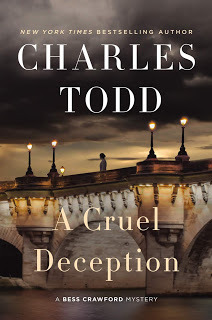 I’ve talked before about how World War I was, for almost a century, the “forgotten war.” The combination of sheer bloody-mindedness and posturing that landed the great powers of Europe in the conflict; the horrific loss of life, limbs, and sanity among those who fought; and the sense of pointlessness heightened by the even greater explosion twenty years later left little sense of triumph among survivors. If World War II was perceived as an epic struggle to defeat evil, its predecessor seemed more like a colossal act of miscalculation and folly.
I’ve talked before about how World War I was, for almost a century, the “forgotten war.” The combination of sheer bloody-mindedness and posturing that landed the great powers of Europe in the conflict; the horrific loss of life, limbs, and sanity among those who fought; and the sense of pointlessness heightened by the even greater explosion twenty years later left little sense of triumph among survivors. If World War II was perceived as an epic struggle to defeat evil, its predecessor seemed more like a colossal act of miscalculation and folly.The centennial of 2014–18 has gone a long way to restoring the balance of interest between the great wars, and in fiction many good works have appeared in the last five years. I’ve covered several of them on this blog, including Jessica Brockmole’s Letters from Skye, Cat Winters’ The Uninvited, the story collection Fall of Poppies, Hazel Gaynor’s Dancing at the Savoy, Gaynor's and Heather Webb's Last Christmas in Paris, and Joan Schweighardt’s Gifts for the Dead. Tracy Chevalier’s latest novel, A Single Thread, also examines the aftermath of the war.
Charles Todd, however, occupies a special place in this literary arena. Long before most people paid much attention to the Great War, as it was then known, this mother/son team decided to focus on the experience and effects of the war in two beautifully written mystery series (and a pair of related stand-alone novels). One, featuring Ian Rutledge, examines the long-term effects on the combatants, most notably shell shock. You can find out more about these novels in my post, “The Black Ascot.” I’ll be revisiting Ian in his next adventure when A Divided Loyalty releases in February 2020.
The other set of books, through the persona of Bess Crawford, looks at the ways in which women’s lives and positions were fundamentally altered by the combat. Just as in World War II, women poured into factories, served as nurses, supported the troops in every way open to them—only to be thrown back into lives constricted by marriage, motherhood, and dependency when the fighting ended. As a result, women’s perceptions—and eventually men’s as well—about the capacities of the “fair sex” changed. The loss of an entire generation of young men only accelerated the trend. It’s not easy to stuff the genie back into the bottle, and that was as true in 1918 as it is now. Modern women owe a great deal to their intrepid great-grandmothers, of whom Bess Crawford offers such a good example.
Charles Todd and I talk about all these things and more—including the challenges of collaborating on thirty or more novels—in my latest interview for New Books in Historical Fiction. And as usual, the rest of this post comes from there.
Writing novels—never mind entire series—takes determination, persistence, imagination, and craft. Charles Todd has added to those natural challenges the joys and complications of creating a single persona from a mother/son team. In A Cruel Deception (William Morrow, 2019), the eleventh in their beloved Bess Crawford series, the strengths of their long collaboration are on full display.
Bess, a British nurse, worked with the wounded throughout the First World War. In A Cruel Deception, the war has ended, and Bess faces the future with some trepidation. So it comes almost as a relief when her former matron requests help finding Lawrence Minton, the matron’s son, missing from the peace talks in Paris.
The search goes well, and Bess tracks Minton to a rural farmhouse, where she confronts him with his addiction to laudanum. He wants nothing to do with her efforts to cure him. Despite his refusal to heal, she soldiers on, aided by a young Frenchwoman who loves him. Bess soon realizes that the root of Minton’s troubles lies in the past, but where?
Only then does it become clear that Minton has an enemy, one who will stop at nothing to settle old scores.
Published on November 01, 2019 06:00



